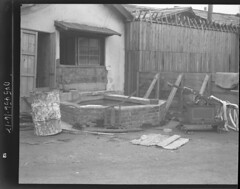Curatorial Records: Numbered Correspondence 8573
War Department,
Office of the Surgeon General,
Army Medical Museum and Library,
Washington
August 18, 1905.
Major Ogden Rafferty,
Surgeon, U.S. Army,
Fort Monroe, Va.
Sir:
I have the honor to report the following as result of the bacteriological examination of four samples of water forwarded by you August 1, 1905, and received at this laboratory on the following day:
Sample A. Creek water, brought in claret wine cask, from New Market Creek, Hampton, Va.
Numerical count 459 bacteria per c.c.
1 c.c. of this water was added to each of 10 glucose bouillon fermentation tubes with the result that all of them contained gas on the third day of incubation. The amount varied from 20% to 60%.
Sample B. New Market Creek water, after treatment by electrolysis.
Numerical count 6491 bacteria per c.c.
Of ten fermentation tubes receiving each 1 c.c. o this water, five contained gas on the third day of incubation, the amount varying from 109% to 85%.
Sample C. Creek water, mixed with a typhoid culture and subjected to electrolysis for five minutes.
Numerical count 23141 bacteria per c.c.
All of the glucose bouillon fermentation tubes charged with 1 c.c. of this water, contained gas on the second day, varying in amount from 55% to 95%. No typhoid bacilli were recovered from this water after inoculating large flasks of sterile bouillon and then using the method of Conradi and Drigalski four days later.
Sample D. The same as sample C. strained through a layer of absorbent cotton.
Numerical count 18616 bacteria per c.c.
The ten fermentation tubes, charged in the usual way with 1 c.c. of this water, all contained gas on the second day of incubation. On the fourth day the amount of gas present ranged from 30% to 75%. All attempts to recover typhoid bacilli from this water resulted in failure.
REMARKS: The failure to recover typhoid bacilli is probably due to the well-established fact that this organism usually disappears from water containing ordinary bacteria within three or four days.
“A” is quite turbid, is tinted red and gives off the aroma of wine.
“B” shows a faint tint, contains a moderate amount of coagulum.
“C” is the most turbid of the set.
“D” contains a moderate amount of coagulum, but is perhaps the clearest of the four. It is possible that the tannin, or other substance in “A” has inhibited multiplication of the bacteria present in that sample.
“B” contained about one-third as many bacteria as “D”, and nearly four times as many as “C”. From the bacteriological standpoint “B” is the least objectionable of the four waters; whether this is due to the mode of treatment or some other cause cannot be well determined without an intimate knowledge of the details of the manipulations. Neither of the samples can be regarded as a good potable water.
Very respectfully,
James Carroll
1st Lieut., Asst. Surgeon, U.S. Army,
Curator, Army Medical Museum























